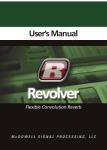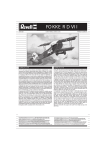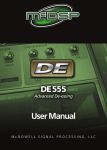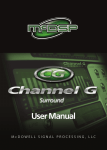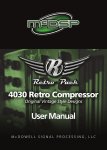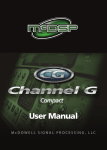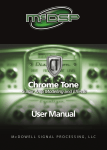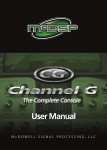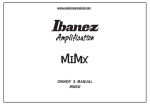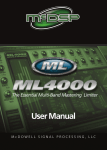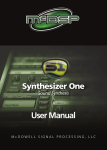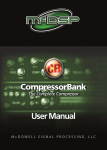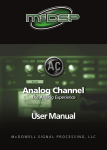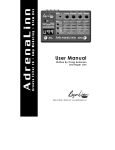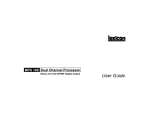Download User Manual
Transcript
Flexible Convolution Reverb User Manual McDOWELL SIGNAL PROCESSING, LLC McDSP Revolver Plug-In Manual McDSP McDowell Signal Processing, LLC 1300 Crittenden Lane #401 Mountain View, CA 94043 Support Email: [email protected] Technical Support: [email protected] World Wide Web: www.mcdsp.com Page ii McDSP Revolver Special Thanks to: • Bert McIntyre and Fokke van Saane • Stephen Hart, James Willets, and James Gangwer at Fantasy Studios from the entire McDSP development team. Copyright Notice: Copyright 1998-2009 McDowell Signal Processing, Limited Liability Company All Rights Reserved. The McDowell Signal Processing, Limited Liability Company’s Revolver Plug-In and corresponding User’s Manual is copyrighted and all rights are reserved. Information in this document is subject to change without notice and does not represent a commitment on the part of McDowell Signal Processing, Limited Liability Company. This document may not, in whole or part, be copied, photocopied, reproduced, translated, or reduced to any electronic medium or machine-readable form for the purpose of resale without prior consent, in writing, from McDowell Signal Processing, Limited Liability Company. Trademarks: McDowell Signal Processing, Limited Liability Company is a trademark of McDowell Signal Processing, Limited Liability Company. Other brands and their products are trademarks of their respective holders and should be noted as such. Digidesign™ and Pro Tools™ are registered trademarks of Digidesign, Inc. mcdsp.com Page iii Table of Contents McDSP Revolver Plug-In Manual McDSP License Agreement Getting Started with Revolver System Requirements Installing the Revolver Plug-In Installation on Mac OS X Installation on Windows XP and Vista Installation on VENUE D-SHOW systems Authorizing your McDSP Plug-Ins Authorizing with a pre-programmed iLok Smart Key Authorizing with an iLok License Card Authorizing with iLok.com Registering your McDSP Plug-In Using your McDSP Plug-Ins Introducing Revolver Attention Revolver LE owners: The features listed below are included in Revolver Native. The Quick Start Tour Revolver Overview Controls The Main Control Page Levels Tweak Contour X Over Plot Display General Information Control Linking Meters Automation Presets: Using the Presets and Making Your Own A Word on Preset Compatibility Page iv ii vi viii viii x x xii xiv xvi xvi xvi xx xxiii xxiii 1 1 1 3 3 5 5 5 7 7 8 9 10 10 10 10 11 11 McDSP Revolver Using the Revolver Plug-In Why Use Reverb? What Is Convolution? Optimizing Revolver Performance Loading Impulse Responses Creating New Impulse Responses Impulse Response Creation Tips and Tricks 12 12 12 13 13 14 15 Revolver Specifications 16 mcdsp.com Page v McDSP License Agreement The software described in this manual is furnished under a license agreement and may be used only in accordance with the terms of the agreement. McDowell Signal Processing, Limited Liability Company License and Warranty: The software which accompanies this license (the “Software”) is the property of McDowell Signal Processing, Limited Liability Company or its licensers and is protected by copyright law. While McDowell Signal Processing, Limited Liability Company continues to own the Software, you will have certain rights to use the Software after your acceptance of this license. Except as may be modified by a license addendum which accompanies this license, your rights and obligations with respect to the use of this Software are as follows: You May: • authorize 1 (one) copy of the Software on 1 (one) PACE Anti-Piracy iLok USB Smart Key, for use with no more than 1 (one) computer at any given time; • make copies of the Software for archival purposes, or copy the software onto the hard disk of your computer and retrain the original for archival purposes; • after written notice to McDowell Signal Processing, Limited Liability Company, transfer the Software on a permanent basis to another person or entity, provided that you retain no copies of the Software and the transferee agrees to the terms of this agreement You may not: • copy, duplicate, or reproduce the documentation which accompanies the Software for the purpose of resale; • sublicense, rent or lease any portion of the Software to a third party without expressed written permission from McDowell Signal Processing, LLC; • reverse engineer, de-compile, disassemble, modify, translate, make any attempt to discover the source code of the Software, or create derivative works from the Software; • make any attempt to circumvent any copy protection software; • use a previous version or copy of the Software after you have received a replacement set or an upgraded version as a replacement of the prior version, unless you donate a previous version of an upgraded version to a charity of your choice, and such charity agrees in writing that it will be the sole end user of the product , and that it will abide by the terms of this agreement. Unless you so donate a previous version of an upgraded version, upon upgrading the Software, all copies of the prior version must be destroyed. Page vi McDSP Limited Warranty: McDowell Signal Processing, Limited Liability Company warrants that the media on which the Software is distributed will be free from defects. Your sole remedy in the event of a breach of this warranty will be that McDowell Signal Processing, Limited Liability Company will, at its option, replace any defective media. McDowell Signal Processing, Limited Liability Company does not warrant that the Software will meet your requirements or that the operation of the Software will be uninterrupted or that the Software will be error-free. THE ABOVE WARRANTY IS EXCLUSIVE AND IN LIEU OF ALL OTHER WARRANTIES, WHETHER EXPRESSED OR IMPLIED, INCLUDING THE IMPLIED WARRANTIES OF MERCHANTABILITY, FITNESS FOR A PARTICULAR PURPOSE AND NON INFRINGEMENT. THIS WARRANTY GIVES YOU SPECIFIC LEGAL RIGHTS. YOU MAY HAVE OTHER RIGHTS, WHICH VARY FROM STATE TO STATE. Disclaimer of Damages: REGARDLESS OF WHETHER ANY REMEDY SET FORTH HEREIN FAILS OF ITS ESSENTIAL PURPOSE, IN NO EVENT WILL McDowell Signal Processing, Limited Liability Company BE LIABLE TO YOU FOR ANY SPECIAL, CONSEQUENTIAL, INDIRECT OR SIMILAR DAMAGES, INCLUDING ANY LOST PROFITS OR LOST DATA ARISING OUT OF THE USE OR INABILITY TO USE THE SOFTWARE EVEN IF McDowell Signal Processing, Limited Liability Company HAS BEEN ADVISED OF THE POSSIBILITY OF SUCH DAMAGES. SOME STATES DO NOT ALLOW THE LIMITATION OR EXCLUSION OF LIABILITY FOR INCIDENTAL OR CONSEQUENTIAL DAMAGES SO THE ABOVE LIMITATION OR EXCLUSION MAY NOT APPLY TO YOU. IN NO CASE SHALL McDowell Signal Processing, Limited Liability Company’s LIABILITY EXCEED THE PURCHASE PRICE FOR THE SOFTWARE. The disclaimers and limitations set forth above will apply regardless of whether you accept the Software. U.S. Government Restricted Rights: RESTRICTED RIGHTS LEGEND: Use, duplication, or disclosure by the Government is subject to restrictions as set forth in subparagraph (c) (1)(ii) of the Rights in Technical Data and Computer Software clause at DFARS 252.227-7013 or subparagraphs (c)(1) and (2) of the Commercial Software Restricted Rights clause at 48 CFR 52.227-19, as applicable, McDowell Signal Processing, Limited Liability Company, Mountain View, CA 94043 ([email protected]). General: This Agreement will be governed by the laws of the State of California. This Agreement may only be modified by a license addendum which accompanies this license or by a written document which has been signed both by you and McDowell Signal Processing, Limited Liability Company. Should you have any questions concerning this Agreement, or if you desire to contact McDowell Signal Processing, Limited Liability Company for any reason, please email: [email protected]. By downloading, using, or copying this Binary Software, Licensee agrees to abide by the intellectual property laws, and all other applicable laws of the U.S., and the terms of this License. Ownership of the software shall remain solely in McDowell Signal Processing, Limited Liability Company. mcdsp.com Page vii Getting Started with Revolver Each McDSP plug-in is delivered inside an installer application, and uses the Interlok copy protection software to authorize each plug-in. This section describes how to install and authorize a McDSP plug-in. General system requirements are also described. System Requirements McDSP HD, Native, and LE plug-ins are compatible with Pro Tools™ HD, HD Accel TDM systems, as well as Pro Tools™ LE and Pro Tools™ M-Powered host based systems. McDSP plug-ins support Mac OS 10.4.x (Tiger), 10.5.x (Leopard), Windows XP and Vista and require Pro Tools 7.x, 8.x or greater. McDSP plug-ins require an iLok USB Smart Key. Configurations McDSP plug-ins are available in TDM, RTAS, and AudioSuite configurations. See individual products for specific available configuration sets. Applications Pro Tools™ 7.x, 8.x or higher is required for TDM, LE, and M-Powered systems. Additionally, a third party software application that supports the Digidesign TDM, RTAS, or AudioSuite plug-in standard may be supported. See http://www. digidesign.com/developers/plugin_info/ for more information. McDSP plug-ins are compatible with the entire Pro Tools™ 7 and 8 product line. Hardware McDSP plug-ins support any Digidesign or approved third party hardware supported in Pro Tools™ 7.x and 8.x. This includes HD, HD Accel, 003, and Mbox host based systems. All McDSP HD plug-ins, except Synthesizer One, also support the Digidesign VENUE D-SHOW systems. See http://www.digidesign.com/ compato/ for more specific information. The McDSP Mac versions are compatible with both Intel and PowerPC based computers. The McDSP Windows versions require an Intel Pentium 4 or greater processor.* Page viii Getting Started * McDSP Windows test machines are chosen to follow the Digidesign recommended systems guide, which currently is the Dell Precision™ Workstation 670 with 2.79 GHz Xeon processor. All products are guaranteed to run on that system. Older Intel processors (i.e. Pentium III and predecessors) and AMD processors are not officially supported, although some users have had limited success with newer AMD processors (i.e. Dual Opteron 1.79 GHZ, Athlon 64 2.20 GHz, and Athlon 64 XP 3700). None of McDSP Windows product line will work with Pro Tools™ 5.x. Also note the McDSP Windows product line does not support MIX, although RTAS versions will work if they exist and the rest of your system (i.e. Pro Tools™ version and processor) is compatible. Please visit mcdsp.com for the latest information about compatibility. mcdsp.com Page ix Installing the Revolver Plug-In Installation on Mac OS X The Revolver plug-in Package includes this manual, ReadMe and Release Notes, a folder of presets for the Revolver plug-in, and the Revolver plug-in. Two copies of the Revolver Licensing Agreement are included - one in this pdf manual and a second as a separate text file. The Revolver plug-in manual requires that Adobe Acrobat reader (or similar .pdf reader) is installed. Both online and boxed version will come with a Revolver installer that will automatically install the Revolver plug-in and its presets on your system. The authorization of the Revolver plug-in is still required after running the installer, and those steps are detailed in the following sections. Installing the Revolver plug-in and presets with the Installer: The online version of the package has been prepared for Internet delivery, and is transmitted as a compressed file in zip format (.zip). In Mac OS X 10.4.x or 10.5.x, simply double click the *.zip file to unpack the installer. The boxed plugin package purchased at your local dealer will be on CDROM. As with the online version, these ‘physical’ versions of the Revolver plug-in package should be copied into a local folder on your system. • Insert the McDSP ‘HD Disk,’ ‘Native Disk,’ or ‘LE Disk’ CDROM onto an available CDROM drive. • Navigate to the Revolver plug-in folder on the CDROM - the installer application is contained therein. • Run the Revolver plug-in Installer application to install (copy) the Revolver plug-in, presets, and documentation to a local folder on your system. The plug-in will be placed in the ‘Plug-Ins’ folder, and the presets will be placed in the ‘Plug-Ins Settings’ folder. • If a previous version of the Revolver plug-in (or other HD, Native, or LE version) was already in the plug-ins folder, it will automatically be updated (or replaced) by the installer. Page x Getting Started Re-installing the Revolver plug-in presets manually: In you wish to restore the factory default presets, it may be useful to know how to manually re-install only the presets. • Go to the ‘Plug-in Settings’ folder: • Root->Library->Application Support->Digidesign->Plug-in Settings • If Pro Tools™ has not already done so for you, create a folder called ‘Revolver’. • Place a copy of the folder from the Revolver plug-in package called ‘Presets’ into the ‘Revolver’ folder. The presets are now viewable (after restarting Pro Tools™) from the settings popup menu from the Revolver plug-in. Note it may be necessary to re-start Pro Tools™ in order for the newly added ‘Presets’ folder to be viewable from the Settings popup inside the Revolver plug-in window toolbar. mcdsp.com Page xi Installation on Windows XP and Vista The Revolver plug-in Package includes this manual, ReadMe and Release Notes, a folder of presets for the Revolver plug-in, and the Revolver plug-in. Two copies of the Revolver Licensing Agreement are included - one in this pdf manual and a second as a separate text file. The Revolver manual requires that Adobe Acrobat reader (or similar .pdf reader) is installed. Both online and boxed version will come with a Revolver installer that will automatically install the Revolver plug-in and its presets on your system. The authorization of the Revolver plug-in is still required after running the installer, and those steps are detailed in the following sections. Installing the Revolver plug-in and presets with the Installer: The Revolver plug-in package purchased at your local dealer will be on CDROM and contain a Windows self extracting executable (.exe) similar to the online Revolver plug-in package prepared for Internet delivery. Both the boxed and online versions the Revolver plug-in executable file will automatically install the plug-in and its presets on your system. Double click the file to launch the installer which will install the Revolver plug-in, presets, and documentation. At any time after installation, you may access the documentation from the Windows ‘Start Menu’ under the ‘McDSP’ group. Authorization of the Revolver plug-in is still required after running the installer, and those steps are detailed in the following sections. Note that after installing new versions of the PACE iLok drivers with the Revolver plug-in installer, you will be prompted by the Revolver plug-in installer to reboot your system. If you are not prompted by the installer, there is no need to reboot. • Insert the McDSP ‘HD Disk,’ ‘Native Disk,’ or ‘LE Disk’ CDROM onto an available CDROM drive. • Navigate to the Revolver plug-in folder on the CDROM - the installer application is contained therein. • Run the Revolver plug-in Installer application to install the Revolver plug-in, presets, and documentation to a local folder on your system. The plug-in will be placed in the ‘Plug-Ins’ folder, and the presets will be placed in the ‘PlugIns Settings’ folder. • If a previous version of the Revolver plug-in (or other HD, Native, or LE version) was already in the plug-ins folder, it will automatically be updated (or replaced) by the installer. Page xii Getting Started Re-installing the Revolver plug-in presets manually: In you wish to restore the factory default presets, it may be useful to know how to manually re-install only the presets. • Go to the Plug-In Settings folder: • C:\Program Files\Common Files\Digidesign\DAE\Plug-In Settings\ • If Pro Tools™ has not already done so for you, create a folder called ‘Revolver’. • Place a copy of the folder from the Revolver plug-in package called ‘Presets’ into the ‘Revolver’ folder. The presets are now viewable (after restarting Pro Tools™) from the settings popup menu from the Revolver plug-in. Note it may be necessary to re-start Pro Tools™ in order for the newly added ‘Presets’ folder to be viewable from the Settings popup inside the Revolver plug-in window toolbar. mcdsp.com Page xiii Installation on VENUE D-SHOW systems The Revolver plug-in Package for VENUE D-SHOW systems includes presets for the Revolver plug-in and the Revolver plug-in. The Revolver Licensing Agreement is displayed when installing the product on D-SHOW. The pdf manual can be obtained by running the Mac OS X or Windows XP/Vista version of the Revolver Pro Tools plug-in installer on any available computer. Both online and boxed versions will come with a VENUE compatible installer that will automatically install the Revolver plug-in and its presets on your system. The authorization of the Revolver plug-in is still required after running the installer, and those steps are detailed in the following sections. Note that all McDSP HD plug-ins, except Synthesizer One support the Digidesign VENUE D-SHOW system. Installing the Revolver plug-in and presets on VENUE with the ‘HD Disk’: The boxed Revolver plug-in package purchased at your local dealer will contain a CDROM titled ‘HD Disk’ that is specially formatted to work with your VENUE console. The VENUE installers are also available online as a compressed zip file download, however you will have to take additional steps to create your own VENUE installer CD-R, see additional instructions below before proceeding with these instructions. Both the boxed and online versions of the Revolver installer are the same and will install both the plug-in and its presets on your system. Note that after installing new versions of the PACE iLok drivers with the Revolver plug-in installer, you will need to reboot your system. You will not be prompted to reboot, and if you don’t you may see an error message saying “TPkd driver required, and a reboot. Please reboot or reinstall the software.’ If you see this message, simply reboot the console and try again. • Insert the McDSP ‘HD Disk’ CDROM onto the CD drive. Note that neither the McDSP ‘Native Disk’ nor the ‘LE Disk’ contains VENUE compatible installers. • Ensure your system is in ‘CONFIG’ mode, you cannot install plug-ins in ‘SHOW’ mode. • Navigate to the ‘OPTIONS’ page and then select the ‘PLUG-INS’ tab. • You should now see the Revolver plug-in available on the left hand side. • Select the Revolver plug-in and select ‘INSTALL.’ • If a previous version of the Revolver plug-in was already installed, it will be updated by the installer. Important note for FilterBank HD and CompressorBank HD on VENUE Page xiv Getting Started D-SHOW consoles: The first time you instantiate either of these plugins, a dialog box will appear asking you to choose a user interface preference. Choose the Knobs interfaces, as some of the Slider interfaces are too large for the VENUE display. Creating a VENUE D-SHOW Installer CD-R from the online zip file: If you do not have a boxed copy of Revolver with the included ‘HD Disk’ CDROM, you can still obtain a copy of the VENUE compatible installers from the www.mcdsp.com website. Once you have located and downloaded the latest VENUE compatible installers from the McDSP website, you will have to take several additional steps to create a VENUE compatible Installer CD-R. For your convenience, all VENUE compatible products are located in the same downloadable zip file, so you will only have to create one CD-R to install all compatible McDSP products. • Unzip the downloaded file and locate the folder named “TDM Plug-Ins” inside the unpacked folder. • Using any CD-R burning application, burn this folder and its contents to an ISO format CD-R. It is recommended that you use a brand new CD-R for this, and do not rewrite an older CD-R. • Once you have burned this folder to a CD-R, you should see it at the root level of the disk (i.e. “D:\TDM Plug-Ins”). Important: If the “TDM Plug-Ins” folder is not located at the root level of the CD-R or has been renamed, the VENUE console may not properly recognize the installer disk. • At this point, you can follow the ‘HD Disk’ installation instructions above to complete the installation. mcdsp.com Page xv Authorizing your McDSP Plug-Ins Authorizing with a pre-programmed iLok Smart Key McDSP bundles such as the Emerald Pack come with a pre-programmed iLok Smart Key. Simply insert the iLok into any available USB port on your computer. The iLok’s indicator light will illuminate when the iLok has a proper connection. The Plug-Ins included in the bundle require no further authorization steps. As with any iLok on your system it is recommended that your iLok be registered and synchronized with iLok.com Authorizing with an iLok License Card All McDSP Plug-Ins require that a valid authorization is present on your iLok USB Smart Key. McDSP Plug-ins that are purchased individually provide this authorization on a plastic License Card (about the size of a credit card), with a small punch-out iLok License Chip. After being separated from the License Card, this iLok License Chip is to be inserted into the ‘key slot’ of the iLok USB Smart Key in order to transfer the authorization from the License Card to the iLok USB Smart Key. Note that each License Card holds ONE Plug-In authorization. The following instructions detail this process Important Note: The Authorization Wizard will prompt the user to register their iLok USB Smart Key at iLok.com. iLok.com is a service offered by PACE Anti-Piracy, Inc. and this step is recommended but NOT REQUIRED by McDSP to complete the authorization of the Plug-In. If you choose to register your iLok USB Smart Key at iLok.com, care must be taken to record your ilok.com account information (i.e. write down your User ID and Password in a safe place). If your iLok.com account information is lost, the iLok cannot be registered to another account and unfortunately there is nothing McDSP can do to help you. See iLok. com for more details about the benefits of using PACE’s iLok.com service. Note: Images in this section are for illustration only, the actual product and screens will be the name of the product you are authorizing. Page xvi Authorizing Your McDSP Plug-Ins Authorizing a McDSP Plug-In from a License Card with the Authorization Wizard: The Authorization Wizard is used to install an authorization from a License Card to the iLok USB Smart Key. To use the Authorization Wizard for the Plug-In you purchase, perform the following steps: • Insert your iLok USB Smart Key into an available USB port. • On a Mac :Locate and launch the ‘Authorizer’ application found in the ‘Authorize’ folder in the Plug-In package for the McDSP Plug-In you purchased on the CD-ROM. • On Windows XP or Vista, just launch Pro Tools™ to authorize the individual McDSP Plug-In you purchased. Note: When authorizing the Plug-In on Windows XP or Vista with a new iLok USB Smart Key, you must insert the iLok USB Smart Key and complete the Windows ‘Found New Hardware Wizard’ before attempting to authorize the Plug-In. • Select the ‘Authorize’ button to be guided through the Authorization Wizard. Note: Selecting the ‘Quit’ button at any time will not authorize the Plug-In or allow it to be used for a trial period. If ‘Quit’ is selected, the Plug-In will not be available in the Pro Tools™ insert menu. • McDSP Plug-Ins require that the user personalize their copy of the Plug-In. A dialog is displayed soliciting this information. Note that the product registration card enclosed with the Plug-In MUST ALSO be filled out as well and returned to McDSP via mail (or fax to 707-2200994). This additional mail-in registration will entitle the user to future upgrades and advance information from McDSP. mcdsp.com Page xvii • Once the Plug-In is personalized, click the ‘Next’ button to continue. • Check the ‘Use License Card’ box and press the ‘Next’ button (figure 2.3). Note: Although the Authorization Wizard may appear to allow authorization by challenge/ response, that method is currently NOT SUPPORTED McDSP Plug-Ins. • Separate the small punch-out iLok License Chip (the removable metal and plastic tab) from the License Card by pushing the cutout up and out with your thumb. Do not force your finger downward. • The iLok License Chip may now be inserted into the ‘key slot’ of the iLok USB Smart Key (figure 2.6). If the iLok USB Smart Key does not appear to be present on the system, ensure the iLok USB Smart Key is connected to a valid USB port and that the green LED is lit inside the iLok USB Smart Key. To insert the License Chip into the iLok USB Smart Key, orient the iLok USB Smart Key’s USB end to the left, and the loop end to the upper right. Insert the metal chip end of the iLok License Chip (the License Chip tab should have the metal chip side facing up towards you, not down). You should be able to visually verify that the License Chip makes contact with the iLok USB Smart Key metal card reader. • The green LED in the iLok USB Smart Key will light when it is ready to receive and transmit data. • Upon inserting the iLok License Chip, a message will be displayed indicating the authorization was installed successfully. Click ‘Ok’ in the message dialog. Page xviii Authorizing Your McDSP Plug-Ins • Once the authorization is installed on the iLok USB Smart Key, a dialog is displayed prompting the user to register their iLok USB Smart Key at the www.ilok.com website. The iLok.com website was created to allow users to manage the software authorizations on their iLok USB Smart Key. THIS STEP IS NOT REQUIRED TO COMPLETE THE AUTHORIZATION OF MCDSP SOFTWARE. The registration of the iLok USB Smart Key to an iLok.com account can be bypassed by clearing the checkbox. The user may also choose to not be asked to register again. While iLok.com is a great resource for the iLok USB Smart Key, your iLok USB Smart Key may only be linked to one iLok.com account. That is, an individual iLok USB Smart Key can only be registered to one account at a time--but a single account can have multiple iLok USB Smart Keys. If the iLok.com account information is lost, the iLok USB Smart Key cannot be registered to another account. However, an iLok USB Smart Key may be transferred between accounts if all the authorizations have been transferred off the iLok USB Smart Key. Register the iLok USB Smart Key to an iLok.com account only when you are ready to retain all the needed iLok.com account information (User ID and Password). • A ‘Finished’ dialog is displayed showing what authorization method was used. • Click ‘Finish’ to exit the Authorization Wizard. mcdsp.com Page xix Authorizing with iLok.com Required for demo, upgrade, and replacement authorizations only iLok.com can be accessed from any Macintosh or PC with an Internet connection. You can do this at home, a friend’s, or at the office as long as there is an internet connection to access iLok.com--note that you don’t have to use your ProTools system computer! You simply use this computer to connect to iLok.com and transfer authorizations to your iLok Smart Key. The iLok Smart Key can then be moved to your ProTools system to complete authorization of your Plug-In. You will need: • A computer with an Internet connection. Either a Macintosh running OS 9.2 to OS 10.3 or a PC running Windows 98, ME, 2000, XP, or Vista • An iLok USB Smart Key • A valid iLok.com account. Visit www.iLok.com and set up a free account, if you have not already done so. 1) Download and install the required client software from iLok.com. 2) Download the desired McDSP Plug-In Installer from: http://www.mcdsp.com/support/updating.html 3) To receive an upgrade or replacement authorization, send email your iLok. com account information to: [email protected] To receive a demo authorization, email your iLok.com account information to: [email protected] Insert your iLok Smart Key into an available USB port and ensure that the indicator light is lit. Once your demo, upgrade, or replacement authorization is available for transfer, your iLok.com account will display the notice saying “You have licenses” on the upper left. Begin by selecting that link. Page xx Authorizing Your McDSP Plug-Ins The next page will display the pending licenses available for download. This page will also display the name of the Plug-In, its manufacturer, the type of authorization (demo, Not For Resale, or License), the date the authorization was deposited, and the date when the authorization will no longer be available for download from the server. Before any transfer of authorizations can take place, you must synchonize your iLok Smart Key with iLok. com. This may take a moment to process depending on your internet connection. Once you have synchronized your iLok, you can select the authorization(s) you wish to transfer to your iLok. If you have multiple iLoks connected to your computer, it is important to select the correct iLok you wish the authorizations to be transferred to. Then click “Download Licenses” to begin the process. Again, this may take a moment depending on your internet connection. When the transfer finishes you will be asked to confirm the completition of the transaction, thereby letting you know that the transfer was successful. mcdsp.com Page xxi If you wish to go back into your account and visually confirm the transaction for yourself, select “View iLoks” Then select the iLok you had the authorizations transferred to. That’s it! Dont forget to logout and move the iLok Smart Key to your ProTools System if you are using another computer for Internet access. Also, you may need to install a different version of the Plug-In if you are upgrading or replacing. Transferring Authorizations with iLok.com You may freely transfer any authorization within your iLok.com account between any of your registered iLok Smart Keys. If you wish to transfer an authorization out of your iLok.com account to a different user, it will require additional support from PACE Anti-Piracy, Inc and may be subject to a service fee or limited by manufacturer restrictions. Check the www.ilok.com website for updates and developments regarding iLok USB Smart Keys and the Pace Interlok Copy Protection system. Page xxii Authorizing Your McDSP Plug-Ins Registering your McDSP Plug-In To register your McDSP Plug-In, fill out and return the product registration card enclosed with the boxed Plug-In package by mail or fax 707-220-0994. Registering your product entitles you to future upgrades and advance information from McDSP. Each individual product must be registered (even if you have multiple copies), and the product must be registered to an individual, not an entity. If you represent a company it is your company’s responsibility to notify McDSP in writing if the individual who registered the Plug-In is no longer with the company. The Company must also be able to supply matching registration information to successfully transfer ownership of the Plug-In. Using your McDSP Plug-Ins Starting a McDSP Plug-In: Follow the installation, authorization, and registration instructions above, Launch Pro Tools™, and the McDSP Plug-In and its presets are ready for use. Refer to the Digidesign™ Pro Tools™ Reference Guide for details on general Plug-In operation such as automation. Exiting a McDSP Plug-In A McDSP Plug-In is exited by clicking on the desktop or other window in the DAE application running the Plug-In, closing the Plug-In window, or de-instantiating the Plug-In. Pro Tools™ sessions will save instantiated Plug-In configurations and their settings. Refer to the Digidesign™ Pro Tools™ Reference Guide for details on general Plug-In operation. Digidesign™ and Pro Tools™ are registered trademarks of Digidesign, Inc. mcdsp.com Page xxiii McDSP Revolver Introducing Revolver Revolver is the ultimate combination of high end reverb control with the sound capacity of convolution. The Revolver plug-in is a highly optimized convolution engine customized for reverb applications. The plug-in comes with over 300 samples (impulse responses) including acoustic spaces and out of production equipment. In addition to the convolution engine, Revolver comes with dedicated and routable EQ, two stereo delay lines, a reverb decay crossover network, and specialized stereo imaging control. The Revolver main controls allow articulation of the sampled impulse response low and high freq response, the overall attack of the impulse response, and a generous pre delay that can delay the wet or dry signal by up to 500 msec. Attention Revolver LE owners: This manual contains a description of the full Revolver plug-in. Revolver LE contains the main control page and impulse library contained in the full Revolver plug-in. For more information on Revolver LE, see the printed quick start guide included with the plug-in. For information on upgrading to the full version of Revolver, see www.mcdsp.com The features listed below are included in Revolver Native. The Revolver delay lines can be synced to MIDI beat clock for a variety of tempobased effects. The reverb can be routed in a number of ways with the delay lines, and a 3-band EQ can be inserted anywhere in the signal path. The delay lines are each 3 seconds long. A tweak page allows adjustment of other acoustic parameters usually only found on synthetic reverbs. The stereo field can be adjusted (even with mono impulse responses) by delaying the left and right channel separately. Special filtering techniques can also be used to modify the stereo image. Diffusion can also be added to the original impulse response to increase the echo density of an otherwise sparse sample. mcdsp.com Page 1 The X-Over (cross over) page breaks the reverb into three frequency bands, and then allows the reverb tails of those bands to be decreased or increased as a percentage of the original reverb length. The Contour page provides unparalleled control of the shape of the reverb. In addition to the Attack control mentioned above, the Hold, Contour, and of course length control can add sublte to dramatic changes to the original impulse response. Revolver is a highly optimized convolution engine. Revolver is capable of getting tremendous amounts of reverb time out of the host processor (for example, up to 70 seconds in a moderate mix using a dual 1.8 G Hz Mac). Additionally, all parameter adjustments are heard immediately, and no outputs are muted during any control updates. The user does not need to wait while the reverb is ‘re-rendered’. Feature List: • Powerful Convolution Engine: Any acoustic space, any outboard gear, any signal path, can be modeled in a few minutes with Revolver and the Revolver analysis tools (full version only). • Flexible routing system rivaling top synthetic reverbs, including insertable EQ, two programmable delay lines, and other stereo field adjustments. • Extensive library with 100’s of samples of real spaces and out of production equipment. • Revolver is compatible with ProTools and other DAW applications that support TDM, RTAS, and Audiosuite plug-in formats. McDSP’s Revolver plugin operates on Mac OS X Tiger 10.4 and later versions (Windows XP version coming in 2008). • Supports Digidesign’s™ ICON, Command 8, ProControl, and Control | 24, and Mackie’s™ HUI external control surfaces. Page 2 McDSP Revolver The Quick Start Tour Start Protools™ and Instantiate the Revolver plug-In • Launch Protools™ and Open a Protools™ Session. • Verify the Display-> Mix Window Shows->Inserts View option is checked. • In one of the inserts of a stereo master fader, select the Revolver plug-In. Note the Revolver plug-in will operate on master or regular audio tracks in mono or stereo versions. • If the insert selection does not show the Revolver plug-In, verify that the Revolver plug-in has been installed correctly. • For more information on starting Pro Tools™ and working with Plug-Ins, see Digidesign’s™ Pro Tools™ Reference Guide Revolver Overview The Revolver plug-in uses convolution to extract and replicate acoustic spaces and other equipment exactly. The Revolver plug-in combines this processing power with the flexibility only found in high end outboard reverbs. The Revolver Length controls the duration of the impulse response, as a percentage of the original impulse response length. The RT60 time, the time it takes for the reveb signal level to fall to roughly - 60 dB, is also displayed. Both the length percentage and RT60 values are updated when the Length control is adjusted. Only the length percentage text field is editable. In addition to the usual reverb length, wet and dry mix controls, Revolver pages mcdsp.com Page 3 of controls grouped into functional blocks. While the user can select any one of these control pages, the reverb length, wet, and dry mix control are displayed at all times. The Control Page selector is located to the left of the impulse response display. Plot Window Tab Navigation Basic Controls Page Controls On all pages Selected by menu in upper left Page 4 McDSP Revolver Controls The Main Control Page The most commonly used controls are in the Main Control Page. • Pre Delay – the amount of time after with the reverb (wet) signal appears at the output. Negative Pre Delay values delay the original (dry) signal instead of the wet signal. • Attack – the initial character of the reverb. Fast attacks (0-10 msec) introduce the reverb signal into the output as quickly as the original impulse response does. Slower attacks (up to 500 msec) smooth the onset of reverberation. • LF Color - the amount of boost or cut (+/- 12 dB) applied to the Low Frequency (LF) portion of the reverb signal. • LF Freq – the frequency at which the LF Color boost or cut is applied. Note the LF Freq control also introduces a low frequency roll off to prevent extreme low frequency data from imparting a ‘boomy’ sound to the reverb signal. • HF Color – the amount of boost or cut (+/- 12 dB) applied to the High Frequency (HF) portion of the reverb signal. • HF Freq – the frequency at which the HF Color boost or cut is applied. Levels The overall mix of each component of the Revolver reverb is adjusted on the Levels Control page. • In – the input signal attenuation. • Out – the output signal attenuation. • Reverb - the output attenuation for the reverb signal • Delay 1 – the output attenuation for Delay 1. mcdsp.com Page 5 • Delay 2 – the output attenuation for Delay 2. Revolver LE only comes with the Main and Levels pages of controls. All other pages listed below are included in the full version of the Revolver plug-In. Equalizer Revolver comes with a 3 band parametric EQ that can be inserted in one of several signal path locations. The EQ parameters are available on this page. The Q for each band is gain dependent, getting narrower as the band gain is increased. • Freq 1, 2, 3 – the frequency at which the band boost or cut is applied. • Gain 1, 2, 3 – the amount of boost or cut (+/- 12 dB) applied at the band frequency. Delay 1, Delay 2 Two separately programmable delay lines are available in Revolver. • Delay – the amount of delay time, up to 3 seconds. The Delay 1 and Delay 2 lines may be inserted in a variety of ways as determined by the Flow Page (explained later in this manual). • BPM (Beats Per Minute) – When synced to MIDI playback tempo, the delay control is locked to the appropriate delay valye. Adjusting the Note, Meter, and Groove controls will only affect delay times when the delay is synced. • Note – the delay time can be selected from a note and meter value. Page 6 McDSP Revolver • Meter – the delay time can be selected from a note and meter value. Note the meter value is the same for both Delay 1 and Delay 2. • Groove – adjust the synced delay time by up to +/- 100% of the delay time of the next smallest note interval. • Feedback – the amount of signal returned to the delay line to create echo and tempo-based effects. Feedback can be positive or negative. • Pan – each Delay line can be panned, up to 100% in the left or right channel. • Level – Delay line output level. This control is repeated in the Levels control page for convenient balance adjustment with dry, wet, and other signals. Tweak Adjustment of the original impulse response’s stereo imaging and diffusion is performed on the Tweak Control Page. • Split – the amount of difference between the left and right channels, as determined by the Split Delay and Split Damp controls. The difference may be applied to the left or right channel (using the other channel as a reference). • S-Delay – the amount of delay time difference, up to 50 msec, between the left and right channels. • S-Damp – the amount of filtering performed in the channel further delayed by the S-Delay control. • Pan – the balance of the left and right reverb signal. • Diffuse Enable – allows affect of Diffuse control to be routed to the reverb output. • Diffuse – the amount of acoustic ‘smearing’ added to an existing impulse response, routed to the reverb output. Contour The overall shape of the impulse response is adjusted from the Contour page. mcdsp.com Page 7 • Attack – the initial character of the reverb. Fast attacks (0-10 msec) introduce the reverb signal into the output as quickly as the original impulse response does. Slower attacks (up to 500 msec) smooth the onset of reverberation. • Hold – the amount of time the shape of the reverb remains unaffected before the Length control begins to fade the impulse response. The hold time also represents the time over which the Contour control operates. • Contour – the amount of boost or cut (+/- 12 dB) applied to the impulse response over the time given by the Hold control. The applied boost or cut reaches its maximum at the end of the Hold time. This control is great to making compressed and gated reverbs maintain a relatively fixed output level, or taming the already too loud impulse response before the length control fade begins. X Over The output of the reverb engine is sent through a three-band cross over, and the reverb decay of each band’s output is adjusted as a percentage of its original length. The crossover network is a system of 24 dB/Oct filters that provide maximum side band rejection and minimal signal leakage into adjacent bands. • Decay – the percentage of the original reverb length. A setting of 100% does nothing, while values less than 100% shorten the decay, and values greater than 100% increase the decay time. • X1, X2 – the crossover frequencies. Page 8 McDSP Revolver Plot Display Along the top of the impulse response plot is a row of tabs, selecting the Display Mode. The Display Mode shows the following data: Impulse – the impulse response data (mono or stereo) is shown across a selectable timeline (as per the zoom controls in the upper right hand corner of the plot). Image – an image of the source location or equipment is shown when available. Plot – displays the frequency repsonse of the LF and HF Color EQ, routable 3-band EQ, and all crossover sections. Flow – the five routing modes for the reverb and Delay 1 and 2 signals is shown. The EQ insert points are displayed along various points in the signal flow diagrams, and can be enabled by simply clicking those insert points. The five modes are listed as tabs along the bottom of the Flow Display Mode page. System – controls uses to optimize the performance of the Revolver convolution engine are shown. These controls are: • Tail Cut – the level (in dB) at which the reverb tail is truncated. • Latency Mode – selectable latency modes. Low latency mode incurs the highest CPU use, while minimizing algorithm delay to just 992 samples (wet and dry signals are delay equally). The medium latency mode incurs significantly less CPU use, and has an algorithm delay of approximately 2000 samples. mcdsp.com Page 9 The Revolver About Box The Revolver About Box contains information on the Revolver plug-In. The About Box can be accessed by clicking the version text in the user interface of any Revolver configuration. General Information To adjust any of the Revolver controls the user can: • Hold the <Command> key while dragging the slider for fine control, or • Click on the text box to highlight and edit the numeric value to get precise control (if a value outside the valid range is input, the control will default to the nearest allowed value when enter is hit) and hit <Enter>, or • Click on the text box to highlight the numeric value and then use the arrow keys to increase or decrease the numeric value, or • Use the <Option> key to bring all the controls to their default values, or • Use hardware controller surfaces supported by the Chrome Tone including the Mackie HUI and Digidesign’s ICON™, ProControl™ and Control 24. Control Linking As of release 1.0, Revolver does not offer any control linking capabilities. Meters Revolver shows signal clipping using a red LED just to the right of the Length percent and RT60 text readouts. Click the LED to clear previous clip indications. Automation Most Revolver controls are completely automatable. See the Digidesign™ Pro Tools™ Reference Guide, Automating Plug-Ins section. Page 10 McDSP Revolver Presets: Using the Presets and Making Your Own The Revolver presets are inspired the pursuit of the ultimate reverb library. Over 300 impulse responses are included with the Revolver Plug-In. More presets are available in other installers included with the boxed copy of the Revolver plugin. The presets can be accessed from the Pro Tools™ “Plug-In Librarian” and “Plug-In Settings” pop-up menus. To make and save your own presets, see the “Plug-In Librarian Functions” section of Digidesign™‘s DigiRack Plug-Ins Guide. A Word on Preset Compatibility Presets for the Revolver and Revolver LE plug-Ins are interchangeable from LE to the full version. Sessions uses Revolver LE will restore correctly in a system with Revolver installed. Note the extra controls included with Revolver (3 band EQ, delay lines, tweak page, contour page (except the Attack control), and X-over page controls)) will not be restored in a system that has only Revolver LE. Pro Tools™ is a registered trademark of Digidesign, Inc. mcdsp.com Page 11 Using the Revolver Plug-In The Revolver plug-in uses a highly optimized (and proprietary) convolution engine to produce the maximum amount of reverb on a host CPU. Additionally, all parameter changes are heard immediately – no waiting for control updates to ‘render’ a new reverb. This chapter covers some of the basics of reverb, convolution, and how the Revolver plug-in combines elements from many Reverb processing methods to deliver a superior sound and user experience. Why Use Reverb? The sounds we hear are comprised of the original source signal, combined with reflected versions from our acoustic environment. These reflections, or reverberations, create a sense of space and proximity. Such effects are useful in creating music productions. The reverb becomes a tool to enhance an otherwise dull track such a vocal recorded in a acoustically dampened vocal booth, or create separation by balancing an original direct sound with a reverberated one. Now the drums sound ‘behind’ the singer, the guitar is ‘over there’, and the vocal has lots of ‘presence’. But if reverb is so great, why not record everything in a reverberant chamber from the start? Even if such acoustic chambers were readily available to every recording studio, different reverbs are generally applied to different groups of tracks. The drum sub might get one reverb, the lead vocal another, and still all the backing vocals something else. In order to effectively create a sense of space and proximity, different reverbs are used on different sets of tracks. What Is Convolution? Convolution is the basic building block of many algorithms. It is the process of taking a known response and applying it to an input signal. The known response can be measured before hand, tweaked and adjusted until the user is satisfied. The advantage to such a process is the ability of the convolution engine to reproduce the exact response from the sample acoustic space or equipment. The disadvantage is the processing power needed to carry out such calculations in realtime has only been available in the last 10 years. McDSP’s engineering staff has taken the capabilities of convolution to new heights by providing a multitude of other processing options to further enhance the sound of the reverb itself. Delay lines, insertable EQ, contour controls, and stereo field adjustments, previously only available on ultra-high-end equipment, are now available in a software product. Page 12 McDSP Revolver Optimizing Revolver Performance The Revolver plug-In’s convolution engine is extremely efficient. This means many Revolver plug-ins can be used in a single session with the minimum amount of CPU power. The control updates are also immediate – no muted outputs or rendering delays are experienced. The user not only has a great sounding reverb, but a responsive one too. Even so, there are ways to further improve the performance of the Revolver plug-In. Using the Display Mode control along the top of the graphs in the middle to upper right corner of the Revolver user interface, select the System page. On this page there are three controls – Tail Cut, Latency Mode, and Stereo Mode. Tail Cut allows the user to select the level (in dB) at which the remainder of the reverb is truncated. This is useful in reducing the amount of CPU power used to calculate the entire reverb output. Most conditions call for a tail cut somewhere between –100 and –120 dB. At these levels the remaining reverb tail is inaudible when combined with other elements of a mix. The control can go as high as –90 dB. Tail Cut also becomes indispensable when the sampled acoustic space or equipment has a noise floor that is higher than the 32 bit audio path available in Revolver. By choosing a Tail Cut that is higher than this noise level, CPU power is not wasted on calculating, well, noise! Using the Display Mode control, select the Impulse page, and zoom out to the maximum range (10 seconds). With this scale you will note when the natural decay of the impulse response levels off and appears to be relatively level. The level at which this signal occurs is the approximate value that should be used for the Tail Cut control value. The Revolver plug-in also has two latency modes – Low Latency and Medium latency. Both are extremely optimized for native processing. Low Latency mode incurs more CPU use, with an output delay of 992 samples. Medium Latency mode incurs less CPU use, with an output delay of roughly 2000 samples. Note when the user adjusts the playback buffer size of their DAW, Revolver will also check which latency mode has been selected and automatically chose the best one. Loading Impulse Responses Revolver comes with hundreds impulse responses, as well as presets for a variety of applications. The presets always contain the original IR data, unless a new preset is loaded that contains another IR sample. This allows uses to make many version of the original IR preset, while insuring all needed IR data is stored with the preset, and/or Pro Tools session. In order to minimze the amount of mcdsp.com Page 13 hard drive space used by each Revolver preset, the IR data is compressed before writing to disk. In order to load in new impulse responses not provided by McDSP, the user pulls up the IR Reader AudioSuite plug-In. The impulse response is imported into ProTools, and then placed on a track (mono or stereo versions of the IR Reader are available). Highlight the audio and press the Analyze buttons in the ProTools toolbar just beneath the IR Reader user interface. Once the process in completed, the impulse response will be displayed in the IR Reader impulse response plot. The IR Reader will automatically locate the best starting point for the impulse response, as well as identify the noise floor present, and fade out the calculated impulse response from the noise floor. Once the new impulse response is calculated, the user can save the impulse response. Note the IR Reader generates impulse response only presets, so the saved preset should be placed in the ‘IR Only’ folder of the Revolver settings files. Creating New Impulse Responses Revolver comes with a set of tools for sweeping acoustic spaces or outboard equipment and turning the processed sweeps into impulse responses for use with the Revolver plug-in. For a detailed example of how to capture impulse responses, refer to the example session and tutorial included in the Impulse Response Library CDROM included with Revolver. Load the session entitled ‘Create Impulse Response’ from the Revolver folder created by the installer. This session will create a mono and stereo send in which an acoustic environment or outboard device can be connected. Now perform the following steps: • Select one of the two sets of 30 second sweeps (mono or stereo). Note the Sweep Generator plug-in can also re-generate these signals if they are erased accidentally. • Connect the outboard equipment into the IO inputs and outputs such that the processed sweep is returned to the session. For acoustic environments, the output is routed to speakers, and microphones, placed at strategic locations in the sampled space, are routed back into the session. See the next section for tips and tricks on recording impulses. • Record enable the track the processed sweep is routed back to. • Press play and record the processed sweep. Page 14 McDSP Revolver • Pull up the Sweep Analyzer Audiosuite Plug-In. • Highlight the original sweep, select the ‘Analyze Sweep’ button, and click analyze. • Highlight the processed sweep, select the ‘Analyze Response’ button, and click analyze. Note this process may take 3 to 5 minutes depending on CPU. • Save the newly created impulse response into the IR Only folder of the Revolver settings folder (the preset is an impulse only setting). • A template session and tutorial on how to capture impulse responses is included in the Revolver Impulse Response Library CDROM that comes with the Revolver plug-in. Impulse Response Creation Tips and Tricks The tools included in the Revolver plug-in are powerful and allow the creation of many new types of reverbs and effects. Making these sounds can be time consuming, but well worth the effort for those who want unique sounds in their productions. In order to make the best use of your time, McDSP has included a list of tips and tricks regarding impulse response creation. • Avoid clipping in any part of the signal path. • When shooting a space or device multiple times, give it plenty of time to settle down. If a previous sound is still reverberating when a new sweep is started, the resulting impulse response will contain the end of the old sweep and the new sweep. • When shooting digital reverbs, try to disable all chorusing effects if possible. mcdsp.com Page 15 Revolver Specifications Parameter Range Function Main Page (available in Revolver and Revolver LE) Input -144 to +12 dB Attenuate input signal level to reverb Output -144 to +12 dB Attenuate output signal from reverb Length 1 to 100 % Percentage of impulse response used to generate reverb. The lenght (in time) of the reverb effect. Wet -144 to +12 dB Attenuate reverb output signal level Dry -144 to +12 dB Attenuate original (dry) signal level Pre-Delay -500 to +500 msec Amount of delay applied to reverb (wet) signal or original (dry) signal Attack 0 to 500 msec Rate at which reverb output reaches maximum level. LF Color - 12 to + 12 dB Amount of boost or cut applied to low frequency portion of reverb output signal LF Freq 40 to 400 Hz Frequency at which the LF Color boost or cut is applied HF Color - 12 to + 12 dB Amount of boost or cut applied to low frequency portion of reverb output signal HF Freq 1000 to 10000 Hz Frequency at which the HF Color boost or cut is applied System Page (available in Revolver and Revolver LE) Tail Cut -140 to -90 dB Level at which reverb tail is truncated to zero Latency Mode Low, Medium Convolution engine modes used to minimize CPU load at the expense of output signal delay Stereo Mode Stereo, Summed Stereo processing mode Gain 1, 2, 3 -12 dB to +12 dB Boost or cut for each EQ band Freq 1 40 to 4000 Hz Freq for THE EQ band Freq 2 80 to 8000 Hz Freq for THE EQ band Freq 3 160 to 16000 Hz Freq for THE EQ band Equalizer Page Page 16 McDSP Revolver Parameter Range Function Delay 1, Delay 2 Pages Delay 0 to 3.0 seconds Delay time BPM 60 to 240 bpm (beats per minute) Tempo used to calculate delay times (used with meter and note control values). Can be entered manually or pulled from session tempo by enabling clock button next to BPM readout. Note there is only one BPM control for both delays. Groove -100 to +100 % Percentage of change in selected delay time, based on BPM, meter, selected note value Feedback -100 to +100 % Percentage of signal feed back into the delay input. Pan -100 to +100 % Mix of delay output to left and right channels Level -144 to +12 dB Attenuation of delay output signal Split -100 to +100 % The amount of effect the Split Delay and Split Damp settings have on the left or right channels. Split Delay 5 to 50 msec Delay difference between left and right channels. Split Damp 2000 to 20000 Hz Low pass filter cutoff frequency for channel further delayed by Split Delay control Split Pan -100 to +100 % Panning of reverb signal to left or right channel Diffuse 0 to 100 % Amount of additional diffusion added to the reverb output. Note the Diffuse control must be enabled with the’On’ button next to the Diffuse control label. Tweak Page mcdsp.com Page 17 www.mcdsp.com Copyright 2009 by McDowell Signal Processing,LLC. All trademarks are property of their respective owners. McDSP is a trademark of McDowell Signal Processing,LLC.









































